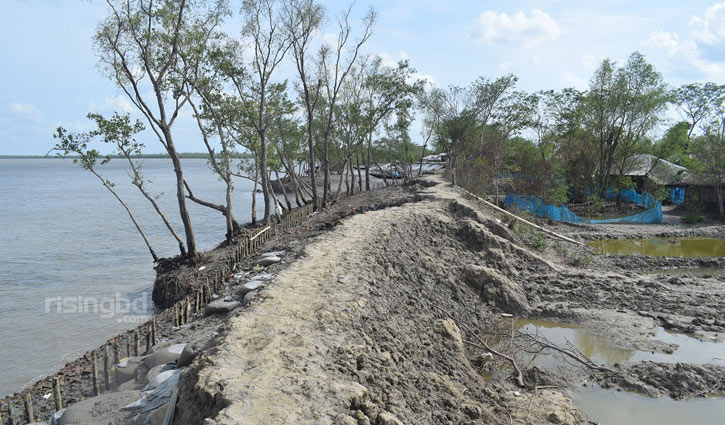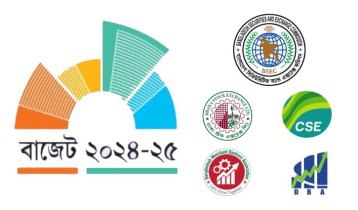Coastal life trapped in embankment
Rafiqul Islam Montu || risingbd.com

Embankments have been set up in coastal areas of the country so that salty water of the sea cannot enter those areas; cornfield, farm, life and livelihood cannot be harmed. Again, fish projects have been adopted in those coastal areas so that foreign currency can be earned through shrimp cultivation by allowing the salty water of the sea in those areas. It is needless to say that these two ‘important’ decisions have been taken keeping the backward coastal people of the country in mind. But are these two decisions not deeming self-contradictory?
After analyzing the existing provisions and laws, it is understood that the matter is not self-contradictory rather it is well coordinated. Embankment will be in place of embankment and shrimp cultivation will be where it is planned. Everything will be as per the rules. These words have been mentioned in the provisions and laws. But in the country of ‘who listens whose words’, all rules have been in the papers. In real sense, an unlimited anarchy exists.
Super cyclonic storm Amphan hit the coastal areas of Bangladesh on the night of May 20. After the cyclone hits, various pictures of anarchy have been surfaced in nine days starting from June 2 to June 10 during the search on the spot. The anarchy was reported in 19 villages under nine unions of four upazilas— Shyamnagar and Assasuni upazilas of Satkhira district and Koyra and Paikgachha upazilas of Khulna district.

Coastal embankments are being used arbitrarily for the interest of individuals. Wealthy and influential people have used the embankments for their own purpose after cutting them capriciously. As a result of this, storms and cyclones have caused a number of chasms in the embankments, making them more vulnerable. Lives and properties of people living in the coastal areas have been inundated. Policymakers visited the spots soon after the incident. Later, projects costing a lot of money have been undertaken. But solutions to the main problems have remained neglected surprisingly. Serviceable, high and sustainable embankments were not built. A little amount has been allotted to repair the embankments. Even some portions of the allotment have gone to another project. Again, reports of unlimited corruption, irregularities and looting have also become evident. As a result, embankments are not fixed in a proper manner. So, origination of storms and cyclones in the Bay of Bengal means huge damage to the life and property of people living in the coastal areas. Cyclone Amphan reminded us of that huge loss.
‘An earnest call for the embankment’
Hajotkhali village in Uttar Bedkashi union under Koyra upazila of Khulna has never seen such erosion earlier. A small canal has flown through the village. There was a sluice gate through which water from Kopotakkho River used to enter the small canal. Someday that sluice gate got broken and inundated the entire village. Cyclone Amphan added more woes to the people of that village. Due to the cyclone, onrush of water flooded both the ends of the canal, putting the entire village under water. Villagers took shelter on the embankment. “MP came to our village before election. At that time, we urged him to build an embankment. He promised to build the embankment but didn’t keep his words,” said Sukumar Chandra Baulia, a villager. The 65-year-old said with tears, “We needn’t relief, just build the embankment for us. We are going to become beggar for the embankment.”
Embankment issue came when they were talking about damage caused by cyclone Amphan to a drug store owned by Abdul Aziz, a Homeopath doctor of Taltola bazar in Protapnagar union under Assasuni upazila of Satkhira district. Fazar Ali Gazi, 73, a resident of Kurikahunia, said, ‘So many cyclones we have witnessed! Every cyclone washes away the soil of the embankment. Embankment gets eroded though cyclone does not occur. 50 to 60-year-old embankment was not repaired. Then how it will exist?’
A scene of terrible erosion becomes visible to eyes while getting on the Kurikahunia launch ghat. Water has entered into at least 1000 feet stretching landslide in four places of the embankment adjacent to the launch ghat. After the storms, local residents set up a ring embankment although it got collapsed again in the pressure of hightide. When asked about the reason of collapse of the embankment, one of the residents replied that it was an old embankment. It has not long been repaired. Abdul Kader, a local resident, made a counter question, ‘It cannot be an embankment, it can be called as a line of land. Do it exist in such a cyclone?’

Lebubunia village under Shyamnagar upazila of Satkhira district is among the names of the areas which were mostly uttered after the cyclone Amphan. Seeing from a far distance, it seemed it could be an island surrounded by water. It is learnt that about 50-feet long embankment got collapsed after cyclone Amphan strikes. The reason behind the collapse is that the embankment was very fragile. There was river water in one end of the embankment and shrimp gher in another end. Besides, there was another canal close to the embankment. The embankment went down as its soil got eroded. Water of Kopotakkho River was always about to flood the embankment. Eventually, the embankment got collapsed due to the strikes of cyclone Amphan.
Around 4.5 crore lives in trap of embankment
Coastal areas are consisted of 19 districts which are located near sea in the southern part of Bangladesh. These coastal areas are home to around 4.5 crore people. In the decade of 1960s, 4800-km long coastal embankment was built to protect the lives and livelihoods of this huge population. The construction of the embankment began in 1961 and completed in 1971. It is a matter of regret that the embankment got collapsed again and again since its construction as it was used for the interest of individuals. According to a source at the Ministry of Water Resources, half of 5,754-km long embankment in the coastal areas remains more vulnerable. Secretary of the Ministry of Water Resources Kabir Bin Anwar said, the embankments were very old and their height left is around three to three and a half meter. The embankments have capacity to endure only high tide of usual time but they have no capacity to endure natural disasters like cyclones Amphan and Sidr. On June 21, the secretary said, ‘The embankment needs to be strengthened by heightening and widening them.’
Patch-work development under salt water
According to a source at the Water Development Board (WDB), no embankments were newly built in the four upazilas where a scrutiny is carried out after the construction of first embankment in the decade of 1960s. What has been done in these areas is the only repairing and ring embankments have been set up in places where they got broken.
The WDB sent DO letter to the Ministry of Water Resources through local lawmaker in every June citing an approximate allocation for the fragile embankments. Allotment came half if it is asked for Tk 3 crore. It is learnt that allotment is sought citing 60 to 70 points every year in Shyamnagar upazila. There are two polders—no. 5 and 15 while there is embankment having a length of 173 km. The allotment that came from the Ministry of Water Resources every year for the repair work of 859-km embankments in the scrutiny conducted four upazilas is many folds the allotment that came from other ministries. A very small portion of that allotment is used for those who become victims of storms and cyclones which can be known from the list of government development expenses of several years applicable for each union of the coastal areas.
Roich Uddin, 83, a dweller of Dubonto Gram Tarafdar Para in Kashimari union of Shyamnagar Upazila said, “We are stuck in the trap of irregularities, mismanagement and negligence. We would not face such misery if the embankment was built strongly. It is manmade problem. We are facing this due to crime of some persons. What’s our fault? Don't we have the right to live in peace? Aren't we citizens of this country?”

Roich Uddin burst into anger. Similar speech came from people of that areas. They have put question – why strong embankments are not being made? Why we will remain in such vulnerable situation? Who will take responsibility of our loss?
Hearing such questions from the people, I returned back Dhaka. I shared those with Habibun Nahar, Deputy Minister, Ministry of Environment, Forest and Climate Change. She repeatedly replied same words– “money crisis”. (Her interview will be published in the last part of this series).
On July 29, Kazi Tofayel Ahmed, Water Development Board Chief Engineer (planning) also Chief monitor of Implemented work taskforce, said basically proper maintenance could not be done due to lack of money. We don’t that get what we want. Tk 3,000 crore to 4,000 crore is not enough to take of all embankment across the country.
However, the list of development task in Burigoalini union depicts different picture. Lot of development works worth around five crore taka took place there in last five years. It would not have been necessary to do so much if the embankment was built properly.
Looting in name of repairing
There is a group of vested quarter comprising some bureaucrat, officials, public representatives, contactors who join looting government’s money in name of embankment repairing tasks.
According to a signboard hanged in Napitkhali village of Gabura union in Shamnagar, repairing task of 820 feet long embankment is scheduled to begin from January 30 this year. The deadline to complete the task was May 21. But, the tasks were started two months earlier of Cyclone Amphan and the process got stuck due to the cyclone. The repairing work has been started again now. However, locals raised their voice regarding irregularities in the project. The embankment was scheduled to make at least three feet high but the authorities made it below one feet high. Besides, the wide of embankment was made less than 13 feet whereas it was proposed to make 14 feet.

According to the rules, if any embankment is made 15 feet high then slope of river side of it should be minimum three times (45 feet). But, only 30 feet slope is seen in river side. On the other hand, less than fifty percent slope is found only in other side of 15 feet height embankment which is not correct according to the embankment building rules. Even, there is a complaint regarding low cost geo bag in the embankment.
Mizanur Rahman Morol, a dweller of Napitkhali village said, if only one kilometer long construction work of that embankment would take place properly then we would not face such misery due to the Cyclone Amphan.
Abul Khayer, Executive Engineer of Water Development Board Satkhira-1 said, “I don’t know the issue. I got a complaint regarding it. I will enquire it. About the irregularities in repairing works, he said, “It’s an old task. Nothing can be said without checking papers.”
Following the alleged irregularities, Kabir Bin Anwar, secretary of water resource ministry on July 21 claimed that the alleged corruption in the ministry has been reduced. Various kinds of steps have been taken to prevent corruption.
Deputy Minister for Water Resources AKM Enamul Haque Shamim said, “In fact, it takes time to complete tasks. Providing money is not everything. We have started working. We are alert to stop stealing.”
Mentioning the issue of contactor’s task selling tendency after getting tender, Deputy Minister said, it’s an important matter. I know about the complaint of selling of tasks. I have declared that no tenders will be allowed to sell tasks. Directions have been provided in the concerned offices in this regard.”

About the directions, Abul Khayer, Executive Engineer of Water Development Board Satkhira-1 said, “We didn’t get such directions yet.”
He also said, “However, there is no rules to handover the tendered tasks. Even, there is no proof of such act. Basically, we receive tasks from that person who takes the tasks from us. Cheques are issued in the names of tender winner. All types of communication is done with that contactor. When contacted about other workers in projects, the contactor tell us that labour leaders are doing the tasks. So, it is not possible to take action against him in this regard. The process can be changed to stop task changing process so that contactors cannot do it.”
Dhaka/Taposh/AI/Nasim























